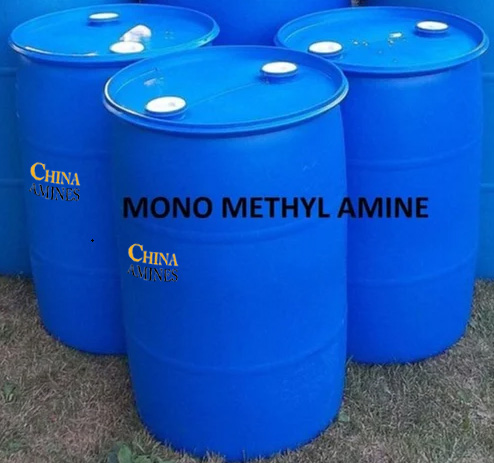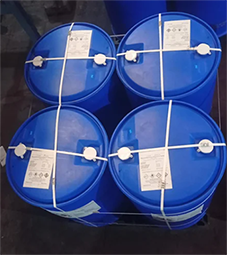Your Questions and Comments
Your sales and customer service desk partners within China Amines Co will continue to serve you. You can also contact us via our headquarter office-
Email:info@chinaamines.com
China Amines Co
Product Profile
1. Chemical Structure and Properties
Active Component:
Monomethylamine (MMA)
Molecular Formula:
CH₅N
Structural Formula:
CH₃NH₂ (primary aliphatic amine).
Solvent:
Methanol (MeOH), Molecular Formula: CH₃OH.
Solution Properties:
- Concentration: 25% w/w MMA in methanol.
- Physical State: Clear, colorless liquid with a sharp, ammonia-like odor.
- Boiling Point: ~65°C (dominated by methanol’s volatility).
- Density: ~0.84 g/cm³ at 20°C.
- pH: Strongly alkaline (pH ~12.0 due to MMA).
- Solubility: Miscible with water, ethanol, and polar organic solvents.
Chemical Reactivity:
- Basicity: MMA acts as a weak base (pKa ~10.6), reacting exothermically with acids to form salts.
- Flammability: Highly flammable (flash point: 12°C; autoignition temperature: 385°C).
2. Industrial Applications
Pharmaceutical Industry:
- Intermediate in synthesizing antitussives (e.g., dextromethorphan) and antiviral drugs (e.g., oseltamivir).
- Example: Used to produce N-methyl intermediates for CNS-active compounds.
Agrochemicals:
- Key precursor for glyphosate herbicides and imidacloprid insecticides (reaction with phosphorus trichloride).
Organic Synthesis:
- Alkylation Agent: Quaternizes fatty acids to produce surfactants (e.g., cocamidopropyl betaine).
- Catalyst: Accelerates esterification and transesterification reactions in biodiesel production.
Electronics Manufacturing:
- Cleaning agent for semiconductor wafers to remove organic residues (e.g., TSMC’s wafer fabrication).
3. Safety and Toxicology
Hazards of MMA:
- Inhalation (≥50 ppm): Severe respiratory irritation, pulmonary edema (LC50 rat, 4h: 2,500 ppm).
- Skin Contact: Corrosive burns (rabbit skin LD50: 400 mg/kg); frostbite risk due to rapid evaporation.
- Eye Exposure: Permanent corneal damage.
Acute Exposure:
- Chronic Effects: Potential neurotoxicity (animal studies).
Hazards of Methanol:
- Toxicity: Metabolizes to formaldehyde and formic acid, causing metabolic acidosis, blindness, or death (oral LD50 rat: 5,600 mg/kg).
- Flammability: High vapor pressure increases explosion risk (flammability range: 6–36% vol in air).
Combined Risks:
- Synergistic Toxicity: Co-exposure amplifies CNS depression and metabolic stress.
- Fire Hazard: Flammable liquid with low flash point; requires explosion-proof equipment.
Protection Measures:
- PPE: Neoprene gloves, chemical goggles, and NIOSH-approved respirators with organic vapor cartridges.
- Engineering Controls: Closed systems, local exhaust ventilation, and grounded containers.
4. Environmental and Regulatory Compliance
Environmental Impact:
- MMA reacts with hydroxyl radicals (half-life ~2 days); methanol contributes to ground-level ozone formation.
- MMA: Rapid aerobic degradation (half-life <7 days).
- Methanol: Readily biodegradable (OECD 301F: >90% in 28 days).
Aquatic Toxicity:
- MMA: LC50 (fish, 96h): 120 mg/L; EC50 (daphnia): 85 mg/L.
- Methanol: LC50 (fish, 96h): 1,000 mg/L; EC50 (algae): 500 mg/L.
Regulatory Frameworks:
- GB 13690-2009: Classified as Class 3.2 Flammable Liquid and Class 8.2 Corrosive Substance.
- OSHA PEL: 10 ppm (MMA), 200 ppm (methanol).
- EPA: Listed on the Toxic Release Inventory (TRI); CERCLA RQ = 100 lbs (MMA).
- CLP Regulation: Classified as Flammable Liquid (Category 2), Acute Tox. 2 (H330), and Skin Corr. 1B (H314).
- REACH: Requires SDS with disposal protocols and risk mitigation measures.
EU:
USA:
China:
Transportation:
UN Number: UN 1230 (Methanol solution, flammable).
Hazard Class: 3 (Flammable Liquid), Packing Group II.
5. Case Studies and Application Insights
Case 1: Glyphosate Herbicide Synthesis
Process: MMA/MeOH reacts with phosphorus trichloride to form methylphosphonous acid, a glyphosate precursor (Bayer process).
Efficiency: 25% solution achieves 90% yield at 65°C with reduced side reactions vs. aqueous systems.
Case 2: Semiconductor Wafer Cleaning
Application: Intel uses MMA/MeOH for post-etch residue removal in 7nm chip fabrication.
Advantage: Lower surface tension than pure methanol, enabling better penetration into nanostructures.
Comparative Analysis:
- Pros: Enhanced solubility for hydrophobic reagents; faster reaction kinetics.
- Cons: Higher flammability and methanol toxicity require stringent safety protocols.



